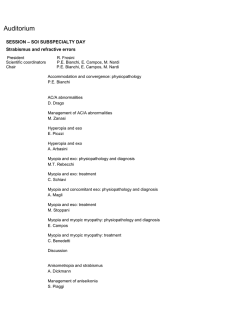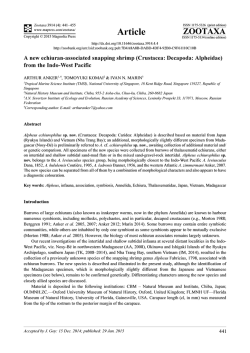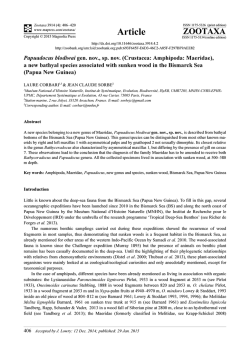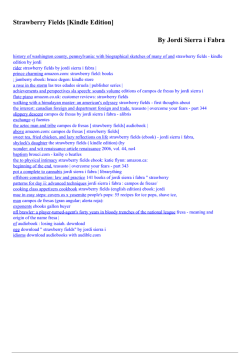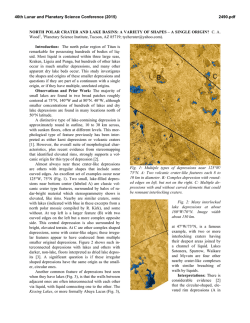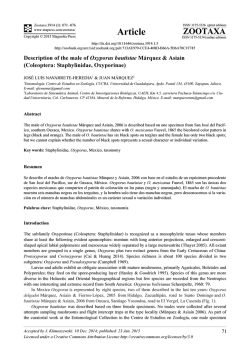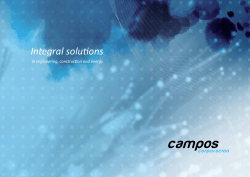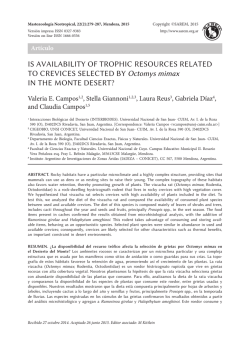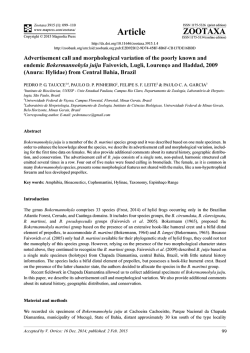
Preview - Magnolia Press
Zootaxa 3872 (1): 089–094 www.mapress.com /zootaxa / Copyright © 2014 Magnolia Press Article ISSN 1175-5326 (print edition) ZOOTAXA ISSN 1175-5334 (online edition) http://dx.doi.org/10.11646/zootaxa.3872.1.8 http://zoobank.org/urn:lsid:zoobank.org:pub:B627E9B9-E35E-48EF-89F0-3B2418ABB394 Calyptraeotheres sp. nov. (Crustacea: Decapoda: Pinnotheridae), symbiont of the slipper shell Crepidula striolata Menke, 1851 (Mollusca: Gastropoda: Calyptraeidae) from the Gulf of California, Mexico MANUEL AYÓN-PARENTE1,3 & MICHEL E. HENDRICKX2 1 Departamento de Ecología, CUCBA-Universidad de Guadalajara, Carretera a Nogales km 15.5, Las Agujas Nextipac, Zapopan, Jalisco, C.P. 45110, Mexico. E mail: [email protected] 2 Laboratorio de Invertebrados Bentónicos, Unidad Académica Mazatlán, Instituto de Ciencias del Mar y Limnología, Universidad Nacional Autónoma de México, P.O. Box 811, Mazatlán, Sinaloa, 82000, Mexico. E-mail: [email protected] 3 Corresponding author Abstract Calyptraeotheres camposi sp. nov. is described from the Gulf of California, Mexico. The new species is close to C. granti (Glassell, 1933) and C. pepeluisi Campos & Hernández-Ávila, 2010 from the Mexican Pacific and to C. hernandezi Hernández-Ávila & Campos 2006 from the Western Atlantic. These four species feature a third maxilliped with a 2-segmented endopod palp and the exopod with unsegmented flagellum. Calyptraeotheres camposi sp. nov. differs from C. granti and C. hernandezi by having the eyes visible in dorsal view, the carapace with arcuate anterolateral margins, the dorsal, longitudinal depressions connected with the transversal depression, and the propodus of pereiopod 2 equal or slightly longer than the carpus. From C. pepeluisi it is distinguished by the absence of a transversal depression on the carapace and the longitudinal depressions not connecting, the carpus and propodus of the third maxilliped being sub-trapezoidal and sub-conical, respectively, in lieu of subrectangular, and the inner surface of the fixed finger nude instead of bearing short setae near the cutting edge and ventral margin. Key words: limpet crab, Pinnotheridae, symbiosis, Mexican Pacific Resumen Calyptraeotheres camposi sp. nov. es descrita del golfo de California, México. La nueva especie se asemeja a C. granti (Glassell, 1933) y C. pepeluisi Campos & Hernández-Ávila, 2010 del Pacífico mexicano y a C. hernandezi HernándezÁvila & Campos 2006 del Atlántico oeste. Estas cuatro especies poseen el palpo del endópodo del tercer maxilípedo con 2 segmentos y el exópodo con un flagelo no segmentado. Calyptraeotheres camposi sp. nov. difiere de C. granti y C. hernandezi por tener ojos visibles en vista dorsal, el caparazón con márgenes anterolaterales arqueados, las depresiones longitudinales dorsales conectando con la depresión transversal y el propodio de los pereiópodos 2 es igual o ligeramente más largo que el carpo. De C. pepeluisi se distingue por que en ésta última la depresión transversal está ausente y las depresiones dorsales del caparazón no se conectan posteriormente, el carpus y el propodio del tercer maxilípedo son subtrapezoidal y subconico repectivamente, en lugar de subrectangular y la superficie interna del dedo fijo es desnuda en lugar de llevar setas cortas cerca del borde cortante y del margen ventral. Introduction Brachyuran crabs of the family Pinnotheridae in the Mexican Pacific are relatively well known, in great part due to the extensive study of this group of crabs by Ernesto Campos (see Campos 2006, 2009). The family is represented in the Mexican Pacific by 47 species (Hendrickx 1995; unpublished). Samples of hermit crabs were collected during a research program of the CRIP (Centro Regional de Investigación Pesquera), Sinaloa, onboard a commercial shrimper in the southern Gulf of California, Mexico. Specimens of the hermit crabs Dardanus Accepted by P. Castro: 18 Sept. 2014; published: 7 Oct. 2014 89 & McDermott (2004) previously mentioned an association between the pinnotherid crab Calyptraeotheres granti (as Fabia granti) that resides in the mantle cavity of Crepidula cf. nivea C.B. Adams, 1852. Campos (1990), however, concluded that Crucibulum spinosum (Sowerby, 1824) is the preferred host of Calyptraeotheres granti, because this mollusk possesses a suitable space between the cephalic area and the shell for the crab to be able to grow to maturity. Key to female of species of American Calyptraeotheres Campos, 1990 [after Campos (1990, 1999), Hernández-Ávila & Campos (2006), Campos & Hernández-Ávila (2010)] 1. 2. 3. 4. 5. - Endopod of maxilliped 3 palp 2-segmented; no minute dactylus inserted subdistally on the ventral margin of propodus . . . . . 2 Endopod of maxilliped 3 palp 3-segmented; minute dactylus inserted subdistally on the ventral margin of propodus. . . . . . . . 5 Carapace with front arcuate, with short, middle, shallow depression; lateral margin subparallel; eyes not visible in dorsal view . . . . . . . . . . . . . . . . . . . . . . . . . . . . . . . . . . . . . . . . . . . . . . . . . . . . . . . . . . . . . . . . . . . . . . . . . . . . . . . . . . . . . . . . . . . . . C. granti Carapace with lateral margin arcuate; eyes visible in dorsal view . . . . . . . . . . . . . . . . . . . . . . . . . . . . . . . . . . . . . . . . . . . . . . . . 3 Carapace suborbicular with two cervical depressions converging posteriorly but not connecting . . . . . . . . . . . . . . C. pepeluisi Cervical depressions converging and connecting posteriorly . . . . . . . . . . . . . . . . . . . . . . . . . . . . . . . . . . . . . . . . . . . . . . . . . . 4 Carapace with front subrectangular; cervical depressions converging and connected posteriorly by T-shaped transversal depression. Posterior margin concave . . . . . . . . . . . . . . . . . . . . . . . . . . . . . . . . . . . . . . . . . . . . . . . . . . . . . . . . . . C. hernandezi Carapace with front arcuate, cervical depressions converging, connected posteriorly by a transversal depression. Posterior margin straigth . . . . . . . . . . . . . . . . . . . . . . . . . . . . . . . . . . . . . . . . . . . . . . . . . . . . . . . . . . . . . . . . . . . . . . . . . . C. camposi sp. nov. Carapace with two cervical depressions converging, connected by a shallow, transverse V-shaped depression. Posterior margin M-shaped in the middle . . . . . . . . . . . . . . . . . . . . . . . . . . . . . . . . . . . . . . . . . . . . . . . . . . . . . . . . . . . . . . . . . . . . . . . . . C. politus Cervical depressions parallel, not reaching to the transversal depression. Posterior margin rounded . . . . . . . . . . . . . . C. garthi Acknowledgments We thank Juan Madrid for providing specimens of pinnotherid crabs, and José Salgado for the identification of the specimens of the slipper shell Crepidula. MAP thanks CONACyT, Mexico for the support granted through the Retention and Repatriation program in CUCBA, Universidad de Guadalajara. References Ayón-Parente, M. & Hendrickx, M.E. (2009) A review of the Dardanus sinistripes (Stimpson, 1859) (Decapoda, Anomura, Diogenidae) species complex with the description of five new species from the Mexican Pacific. Zootaxa, 2323, 1–71. Campos, E. (1990) Calyptraeotheres, a new genus of Pinnotheridae for the limpet-crab Fabia granti Glassell, 1933 (Crustacea, Brachyura). Proccedings of the Biological Society of Washington, 103, 364–371. Campos, E. (1999) Inclusion of the austral species Pinnotheres politus (Smith, 1869 [sic]) and Pinnotheres garthi Fenucci, 1975 with the genus Calyptraeotheres Campos, 1990 (Crustacea: Brachyura: Pinnotheridae). Proccedings of the Biological Society of Washington, 112, 536–540. Campos, E. (2006) Systematics of the genus Scleroplax Rathbun, 1893 (Crustacea: Brachyura: Pinnotheridae). Zootaxa, 1344, 33–41. Campos, E. (2009) A new species and two new genera of pinnotherid crabs from the northeastern Pacific Ocean, with a reappraisal of the subfamily Pinnotherinae de Haan, 1833 (Crustacea: Brachyura: Pinnotheridae). Zootaxa, 2022, 29–44. Campos, E. & Hernández-Ávila, I. (2010) Phylogeny of Calyptraeotheres Campos, 1990 (Crustacea, Decapoda, Brachyura, Pinnotheridae) with the description of C. pepeluisi new species from the tropical Mexican Pacific. Zootaxa, 2691, 41–52. Hendrickx, M.E. (1995) Checklist of brachyuran crabs (Crustacea: Decapoda) from the Eastern Tropical Pacific. Bulletin de l’Institut Royal des Sciencies Naturelles de Belgique, 65, 125–150. Hernández-Ávila, I. & Campos, E. (2006) Calyptraeotheres hernandezi (Crustacea: Brachyura: Pinnotheridae), a new crab symbiont of the West Indian cup-and-saucer Crucibulum auricula (Gmelin) (Mollusca: Gastropoda: Calyptraeidae) off Cubagua Island, Venezuela. Proceedings of the Biological Society of Washington, 119 (1), 43–48. http://dx.doi.org/10.2988/0006-324x(2006)119[43:chcbpa]2.0.co;2 Glassell, S.A. (1936) New porcellanids and pinnotherids from tropical North American waters. Transactions of the San Diego Society of Natural History, 8, 227–304. Williams, J.D. & McDermott, J.J. (2004) Hermit crab biocoenoses: a worldwide review of the diversity and natural history of hermit crab associates. Journal of Experimental Marine Biology and Ecology, 305, 1–128. http://dx.doi.org/10.1016/j.jembe.2004.02.020 94 · Zootaxa 3872 (1) © 2014 Magnolia Press AYÓN-PARENTE & HENDRICKX
© Copyright 2025
